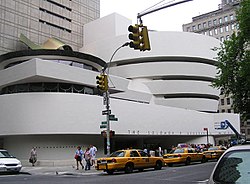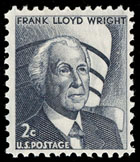Solomon R. Guggenheim Museum: Difference between revisions
m iw fi |
|||
| Line 67: | Line 67: | ||
* [http://maps.google.com/maps?ll=40.782892,-73.958920&spn=0.005107,0.007854&t=k&hl=en Google maps] |
* [http://maps.google.com/maps?ll=40.782892,-73.958920&spn=0.005107,0.007854&t=k&hl=en Google maps] |
||
* [http://www.guggenheim.org/exhibitions/past_exhibitions/motorcycle/motorcycle.html Art of the Motorcycle Exhibit] |
* [http://www.guggenheim.org/exhibitions/past_exhibitions/motorcycle/motorcycle.html Art of the Motorcycle Exhibit] |
||
* [http://www.greatbuildings.com/buildings/Guggenheim_Museum.html Guggenheim Museum at Great Buildings] |
|||
<!-- Precise Coordinates of the center of the circular part of the ceiling--> |
<!-- Precise Coordinates of the center of the circular part of the ceiling--> |
||
Revision as of 19:47, 28 February 2008

- This article refers to the Guggenheim Museum in the Upper East Side of Manhattan (New York). There are a number of other Guggenheim Museums.
The Solomon R. Guggenheim Museum, founded in 1937, is a modern art museum located on the Upper East Side in New York City. It is the best-known of several museums owned and/or operated by the Solomon R. Guggenheim Foundation, and is often called simply The Guggenheim. It is one of the best-known museums in New York City.
History


Originally called "The Museum of Non-Objective Painting," the Guggenheim was founded to showcase avant-garde art by early modernists such as Wassily Kandinsky and Piet Mondrian. It moved to its present location, at the corners of 89th Street and Fifth Avenue (overlooking Central Park), in 1959, when Frank Lloyd Wright's design for the site was completed.
The distinctive building, Wright's last major work, instantly polarized architecture critics,[1] though today it is widely revered.[2] From the street, the building looks approximately like a white ribbon curled into a cylindrical stack, slightly wider at the top than the bottom. Its appearance is in sharp contrast to the more typically boxy Manhattan buildings that surround it, a fact relished by Wright who claimed that his museum would make the nearby Metropolitan Museum of Art "look like a Protestant barn."[1]

Internally, the viewing gallery forms a gentle spiral from the ground level up to the top of the building. Paintings are displayed along the walls of the spiral and also in viewing rooms found at stages along the way.
Most criticism of the building has focused on the idea that it overshadows the artworks displayed within, and that it is particularly difficult to properly hang paintings in the shallow windowless exhibition niches which surround the central spiral. Although the rotunda is generously lit by a large skylight, the niches are heavily shadowed by the walkway itself, leaving the art to be lit largely by artificial light. The walls of the niches are neither vertical nor flat (most are gently concave) meaning canvasses must be mounted proud of the wall's surface. The limited space within the niches means that sculptures are generally relegated to plinths amid the main spiral walkway itself. Prior to its opening, twenty-one artists signed a letter protesting the display of their work in such a space.[1]

In 1992, the building was supplemented by an adjoining rectangular tower, taller than the original spiral, designed by Gwathmey Siegel and Associates Architects. By that point, the building had become iconic enough that this augmentation of Wright's original design was itself controversial.
In October 2005, Lisa Dennison was appointed director of the Solomon R. Guggenheim Museum in New York.
Thomas Krens remains director of the Solomon R. Guggenheim Foundation, having recently won a decisive victory over billionaire philanthropist and board member Peter Lewis. A significant contributor to the Guggenheim foundation, Lewis resigned in 2005 in a dispute with the board over the direction and leadership of the foundation. Despite this, Krens and Lewis nevertheless continue to agree in describing the building itself as "the most important piece of art in the collection."[3]...link to blog thread with digitized photographs
2007-2008 exterior restoration
The Guggenheim’s exterior and infrastructure will be restored, requiring only limited structural interventions. Experts in the field of landmark restoration and preservation formulated a methodology –- using the latest techniques and materials unavailable to Frank Lloyd Wright in the 1950s....link to press release
In the first phase of this project, a team of restoration architects, structural engineers, and architectural conservators worked together to create a comprehensive assessment of the building's current condition. This included
- the removal of 11 coats of paint from the original surface, revealing hundreds of cracks caused over the years, primarily from seasonal temperature fluctuations...link to graphic detailing location of exterior cracks
- detailed monitoring of the movement of selected cracks over 17 months
- impact-echo technology, in which sound waves are sent into the concrete and the rebound is measured in order to locate voids within the walls
- extensive laser surveys of the exterior and interior surfaces, believed to be the largest laser model ever constructed
- core drilling to gather samples of the original concrete and other construction materials
- testing of potential repair materials.[4]
Much of the interior of the building was restored during the 1992 renovation and addition by Gwathmey Siegel and Associates Architects. The 2007-2008 restoration primarily addresses the exterior of the original building and the infrastructure. This includes the skylights, windows, doors, concrete and gunite facades and exterior sidewalk, as well as the climate-control. The goal will be to preserve as much significant historical fabric of the Solomon R. Guggenheim Museum as possible, while accomplishing necessary repairs and attaining a suitable environment for the building’s continuing use as a museum....link to podcast about restoration (10 MB, audio only, 8 min 45 sec)
The $29 million restoration is made possible through the support of Peter B. Lewis, the Board of Trustees of the Solomon R. Guggenheim Foundation, the City of New York and the State of New York. The restoration work is projected to be complete and the scaffolding to come down by late spring of 2008. ...link to streaming video, broadband only
References in popular culture
- In the film L.A. Story, Steve Martin's character has fun roller-skating through an art museum as a friend videotapes him. An acquaintance he meets in the art museum asks him, "Have you tried the Guggenheim?"
- In "The Race," a 1994 episode of Seinfeld, George claims to have been the architect of the 1992 addition.
- In the episode "Art" of the Dilbert TV Series the Guggenheim is seen as being remodeled in accordance with a popular modern art fad.
- The exterior of the Guggenheim Museum can be seen in the opening sequence of The Critic.
- In the movie Aftershock: Earthquake in New York, it is destroyed by an earthquake.
- The movie Men In Black has Will Smith chasing an alien along the ramp.
- The movie "The Order - From Matthew Barney's Cremaster Cycle 3" was also filmed here.
- The Guggenheim Museum can be built as a landmark in Sim City 4 Rush Hour
- The Guggenheim can be seen in the film Downtown 81 starring the artist Jean Michel Basquiat
- In Michael Almereyda's 2000 film version of Hamlet, part of Ophelia's (played by Julia Stiles) mad scene takes place in the museum.
- In some movies filmed in New York, a number of them show part or all the of the Mueseum.
See also
References
- ^ a b c Last Monument. Time Magazine, November 2, 1959
- ^ The Wright Stuff. USA Weekend, November 6, 1998
- ^ Vogel, Carol. "Guggenheim Reviving Its Main Asset: Itself," New York Times. June 10, 2004.
- ^ Pogrebin, Robin. "The Restorers' Art of the Invisible: Meet the New Guggenheim, Same as the Old Guggenheim (but Better)," New York Times. September 10, 2007, pp. E1-5; Haeyoun Park, "Face-lift for an Aging Museum," New York Times. April 16, 2007.
